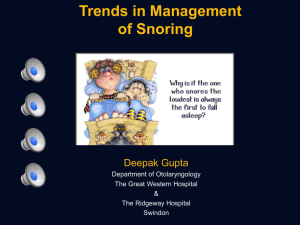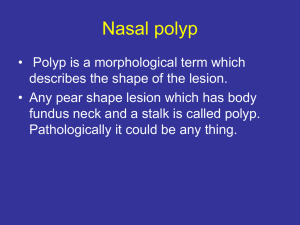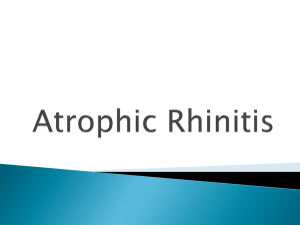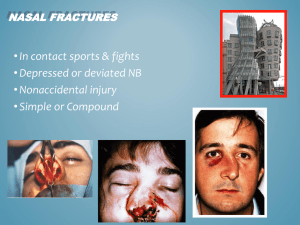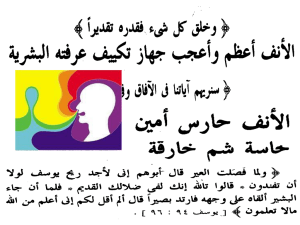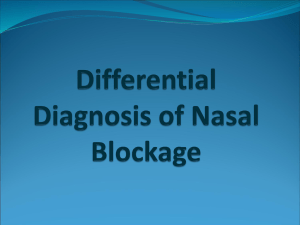Snoring - Gary Kroukamp
advertisement
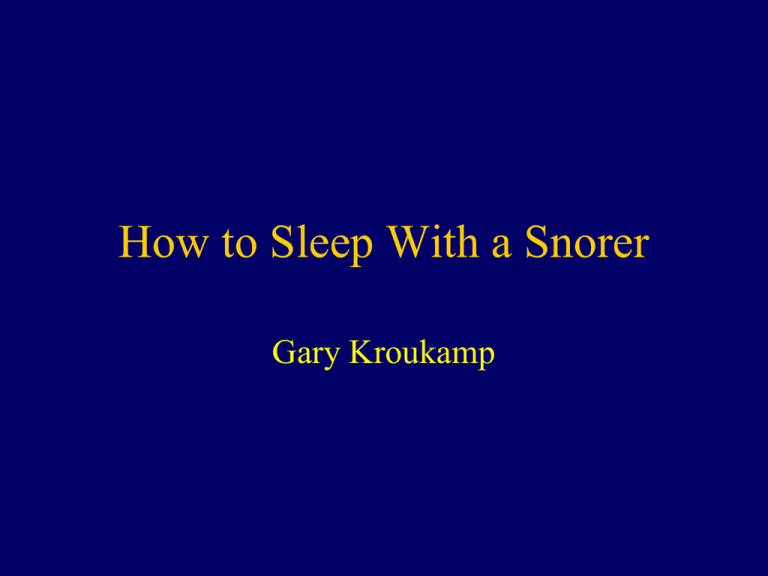
How to Sleep With a Snorer Gary Kroukamp “Laugh and the world laughs with you; snore and you sleep alone.” anon. Snoring • 40% of men and 30% of women (30 to 60 years) • Increases to 80% and 70% in 7th decade • Self reporting and partner reporting are inaccurate Anatomical levels of obstruction Oropharyngeal Abnormalities Pathophysiology of snoring Sounds of snoring originate in collapsible parts of upper airway due to 3 factors: • Reduction in pharyngeal muscle tone muscle tone reduced in sleep and exacerbated by alcohol, sedatives, hypothyroidism • Space-occupying masses impinging on airway tonsils/adenoids, obesity, long soft palate/uvula, retro- or micrognathia, macroglossia, tumours polyps and cysts • Restriction of nasal airflow septal deviation, ostiomeatal and turbinate abnormalities, allergic and vasomotor rhinitis Definitions • Snoring – undesirable sound due to Bernoulli effect, alternating higher and lower airway pressures due to narrowing, causes vibration • Obstructive Sleep Apnoea Syndrome – No airflow for more than 10 seconds, until a “resuscitative gasp” occurs, more than 5 episodes per hour, drop in sats of > 4% Classification of disease severity • Primary snoring – RDI < 5, normal sats, no daytime sleepiness • Upper Airway Resistance Syndrome – RDI < 5, normal sats, excessive daytime sleepiness • Obstructive Sleep Apnoea Syndrome – RDI >5, Sats < 90, excessive daytime sleepiness THE EPWORTH SLEEPINESS SCALE How likely are you to doze off or fall asleep in the situations described below, in contrast to just feeling tired? Even if you haven’t done some of these things recently, try to work out how they would have affected you. Use the following scale to choose the most appropriate number for each situation: 0 = Would never doze 1 = Slight chance of dozing 2 = Moderate chance of dozing 3 = High chance of dozing Situation Sitting and reading Watching TV Sitting, inactive in a public place (eg theatre or meeting) As a passenger in a car for an hour without a break Lying down to rest in the afternoon when circumstances permit Sitting and talking to someone Sitting quietly after lunch without alcohol In a car, while stopped for a few minutes in the traffic Chance of dozing Thank you for your co-operation Diagnosis • Physical examination • Vital signs and BMI/collar size • Head and neck/upper airway examination • Special Investigations • Polysomnography (Sleep study) – Gold standard/mandatory, determines AI, RDI, Sats • Split night polysomnography • Fibreoptic endoscopy (Mueller manoeuvre/Sleep endoscopy) • Cephalometry • CT/MRI • Oximetry • Thyroid function,Cardiac evaluation, CXR Fibreoptic Endoscopy • Good for nasal deformities • Retroglossal or retropalatal obstruction • Mueller manoeuvre Endoscopy and Mueller Manoeuvre Non-Surgical Treatment for Snoring • Nasal CPAP – first-line therapy, 50% compliance • Elimination of alcohol • Oral/Dental appliances – 50% success rate • Nasal appliances • Positional devices – apnoea more common when supine • Weight loss – very difficult Nasal CPAP Surgical Treatment for Snoring • Nasal procedures • Adeno/Tonsillectomy • Palatal procedures (LAUP, UPPP, coblation,implants) • Maxillo-facial procedures What constitutes a successful surgical outcome? • 50% improvement in RDI Nasal Surgery? • If obvious nasal abnormality • Neural reflex mechanism – apnoea on decreased nasal afferent input • Nasal obstruction causes negative inspiratory pressure and may cause pharyngeal collapse • • • • Nasal Valve surgery Septoplasty Turbinate surgery Nasal Polypectomy/FESS Palatal Procedures • Uvulopalatopharyngoplasty (UPPP) • Laser Assisted Uvulopalatoplasty • Radiofrequency Volumetric Tissue Reduction • Pillar procedure UPPP • • • • • Since 1952 - Japan Reduction of excessive tissue Includes tonsillectomy General anaesthetic 40% to 80% effective in snoring UPPP Post-Operative View UPPP Disadvantages of UPPP • PAIN • Over-resection of palatal tissue with incompetence (of palate and surgeon!) • Stenosis • Haemorrhage • Swallowing impairment • Pharyngeal discomfort/dryness • Speech disturbance LAUP • • • • • • • Good for simple snoring – 95% initial success Easy Outpatient Local anaesthetic Multiple treatments PAIN!! Expensive equipment Operative Technique - LAUP Radiofrequency Volumetric Tissue Reduction • • • • • • • Similar to LAUP Tissue necrosis and healing by scarring Outpatient procedure Local anaesthetic Multiple procedures required Not painful Promising early results in snoring Pillar Procedure • • • • Single procedure Not painful Local anaesthetic FDA approved Literature Otorhinolaryngology – Head and Neck Surgery 2006 • Retrospective review 125 patients – not funded by manufacturers • Done alone and with Nasal/palatal/pharyngeal procedures • Snorers and mild/moderate OSAS • Subjective “cure” – 88% (Partner VAS and Epworth Sleepiness Scale) • Objective “cure” – 34.4% (Sleep Study) • Extrusion rate – 8% Subjective Improvement in Snoring 100 90 80 70 60 50 40 30 20 10 0 Pillar only Pillar&Nasal Pillar& Pillar&UPPP

